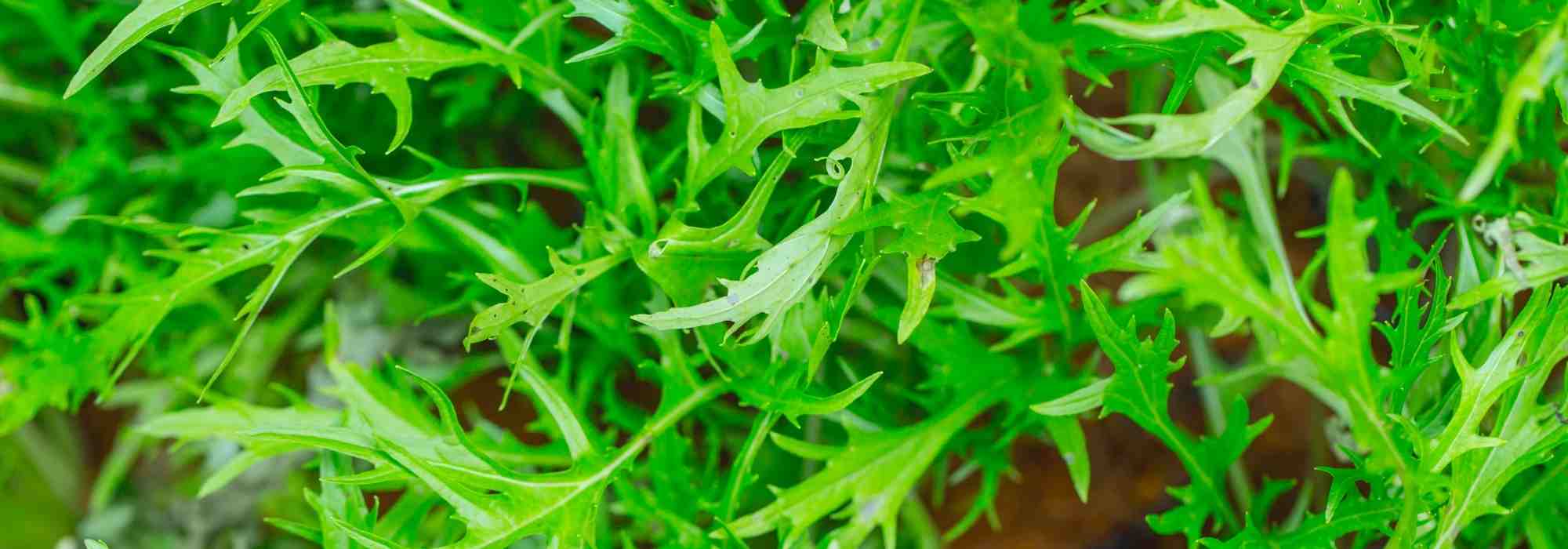
Mizuna: sowing, growing
Contents
Mizuna in a nutshell
- It is an ancient Japanese cabbage traditionally grown in the former imperial city of Kyoto
- This leafy vegetable with a slight peppery taste is enjoyed in mesclun or cooked like spinach
- Seeds of mizuna are sown in spring or autumn in any good garden soil that remains cool
- It makes an excellent winter salad
- Hardy and low-maintenance, it is packed with qualities, both in taste and nutrition
A word from our expert
Mizuna –Brassica Rapa– is a leaf vegetable of Japanese origin, belonging to the cabbage family, already cultivated in the ancient imperial city of Kyoto: it is one of those vegetables, the “Kyo-Yasai”, of exceptional taste quality that delighted the emperor! This Japanese salad, known mainly to enthusiasts of Asian cuisine, deserves a place in our vegetable gardens alongside other delicious greens!
Its leaves have a slightly peppery flavour, yet milder than that of rocket. Alongside the classic Mizuna cabbage with its vigorous, dentate green leaves, there is a red variety with a hint of mustard flavour.
In the kitchen, in terms of recipes, it can be consumed both raw and cooked: in a mesclun or quickly stir-fried in a wok, in soup, or braised like spinach, or as a condiment to flavour pickled gherkins.
Low in calories, rich in antioxidants and vitamins C, K, and A, this Japanese cabbage is a superfood with very interesting medicinal properties.
Easy to grow, it thrives in fresh, well-manured soil. Not fearing the cold but dreading the heat that encourages it to bolt, the best time to grow it is from September to May.
Here’s how to sow and cultivate it well!
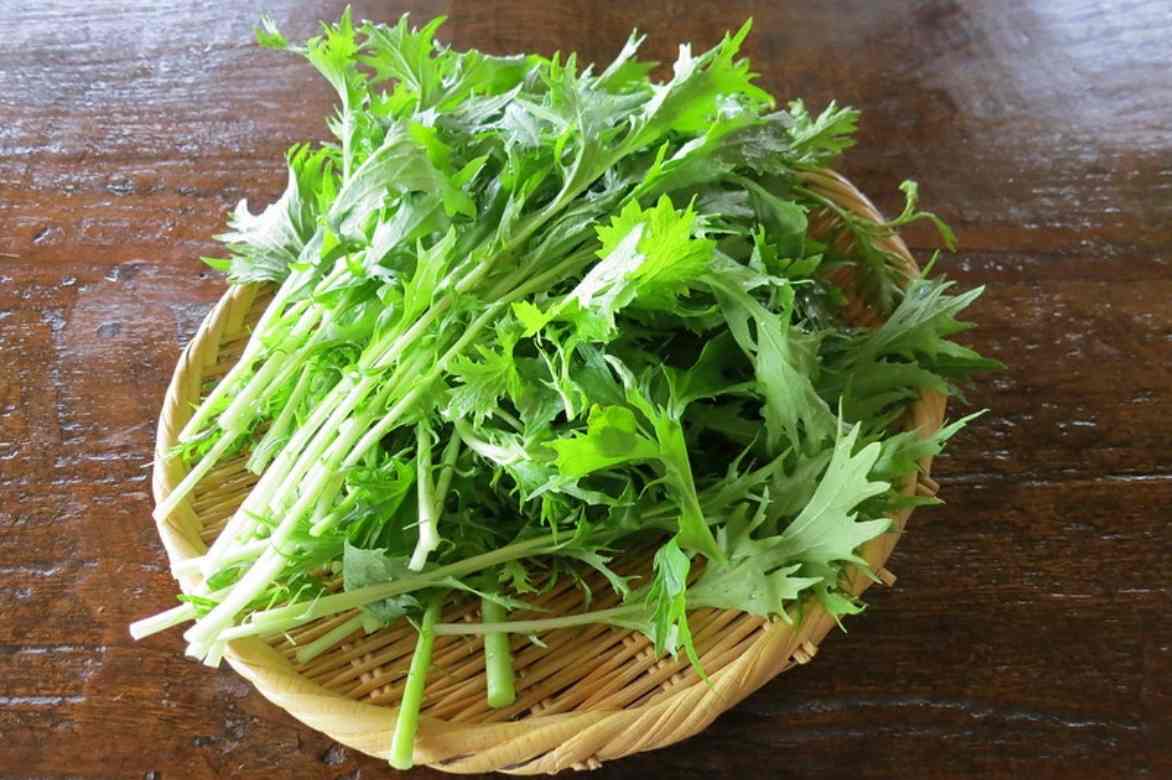
Description and botany
Botanical data
- Latin name Mizuna
- Family Brassicaceae
- Common name Mizuna, Salad cabbage
- Flowering May-June
- Height 0.15 to 0.40 m
- Exposure Sun, Partial shade
- Soil type well-drained, cool
- Hardiness -12°C
Mizuna, in Latin ‘Brassica rapa‘, also known as “Japanese mustard” and “salad cabbage,” is a vegetable plant from the large family of Brassicaceae, which includes cabbages, turnips, mustard, and rutabaga, comprising nearly 4000 species. This ancient Japanese cabbage originates from the coastal regions of northern China, Korea, and Japan. It is part of the “Kyo-Yasai,” these very tasty vegetables traditionally cultivated until the end of the Edo period (1868) in the Kyoto region, the former imperial city. Only a few vegetables, such as Shôgoin-Daikon, a type of white radish, are officially recognised as “Kyô-yasai.”
In our gardens, we mainly cultivate Brassica rapa japonica, syn. Brassica rapa nipposinica and Brassica campestris, which are biennial or annual species.
This leafy vegetable forms a rosette of leaves 15 to 25 cm high, spreading about 25 cm. It produces numerous tender green to emerald green leaves, laciniate with more or less prominent white midribs, similar to those of rocket or dandelion. The Mizuna ‘Kyoto’ is a variety of Asian cabbage distinguished by its rosettes of large leaves resembling curly chicory, supported by long white petioles. Some varieties differ from the typical species by their lovely purple leaves.
 The highly dissected and diverse foliage of Mizuna. Purple Mizuna in the centre (Photo: F. Delventhal)
The highly dissected and diverse foliage of Mizuna. Purple Mizuna in the centre (Photo: F. Delventhal)
The leaves become sparse in the lower part. They have a flavour that is both mild, peppery, and slightly spicy, which has earned this Japanese salad cabbage the nickname “Japanese mustard.” Growth is rapid, and it is harvested from July to December. The young shoots of mizuna are mainly consumed raw in salads and mesclun but can also be cooked like spinach for the older leaves.
As with all crucifers, the flowering that occurs in May-June takes the form of clusters of flowers composed of 4 yellow petals arranged in a cross. This is followed by dehiscent siliques containing seeds that you can harvest for your future sowing.
Mizuna is a type of cabbage that is still relatively unknown in Europe, where it was introduced after the Second World War.
“`
Main species
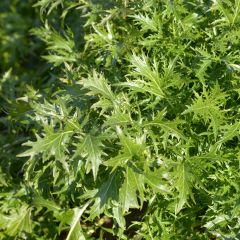
Mizuna Cabbage - Ferme de Sainte Marthe Seeds
- Height at maturity 20 cm
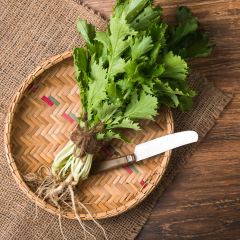
Mizuna Kyoto - untreated Field Mustard seeds - Ferme de Sainte Marthe seeds
- Height at maturity 20 cm
Discover other Mizuna
View all →Available in 1 sizes
Available in 1 sizes
Available in 1 sizes
Sowing and planting mizuna
Where to sow it?
Well resistant to cold (down to -12°C), mizuna can be grown in all regions. It thrives in full sun or partial shade in the south of our country and shares the same requirements as all cabbages: it needs deep, well-worked, cool but well-drained soil that does not dry out. However, it will adapt to any good garden soil. It is a greedy vegetable that requires well-manured compost-rich soil, high in nitrogen.
It is grown in the vegetable garden alongside other leafy vegetables, and it can also find its place in pots or planters on the balcony or terrace, or indoors in a pocket garden that allows for year-round harvesting.
When to sow mizuna?
Mizuna is sown in a heated shelter from February to May when no more frost is expected. Heat can cause premature bolting. Therefore, it is best to sow it from April for an early summer harvest, and to resume sowing from September to December to enjoy a winter harvest. Tip: stagger your sowings to extend the harvest period! The germination temperature for Mizuna is around 14°C: from October to December, sow under a frame or unheated tunnel.
How to sow mizuna?
Under shelter
- Sow the seeds at a depth of 1 to 2 cm in good seed compost or sifted soil
- Cover the seeds with a little compost
- Keep the substrate moist but not waterlogged
- When the plants have 4 leaves, thin them out and transplant them into the garden, spaced 20 cm apart
Direct sowing
Mizuna seeds are sown in well-amended compost and finely worked soil.
- Loosen the soil deeply and enrich it with compost,
- Sow the seeds in deep furrows of one or two centimetres, spaced 20 centimetres apart,
- Cover with a thin layer of soil,
- Firm down and water lightly,
- Keep the soil moist until germination (about 14 days),
- When the seedlings are well developed, thin them out, keeping one plant every 20 cm or so.
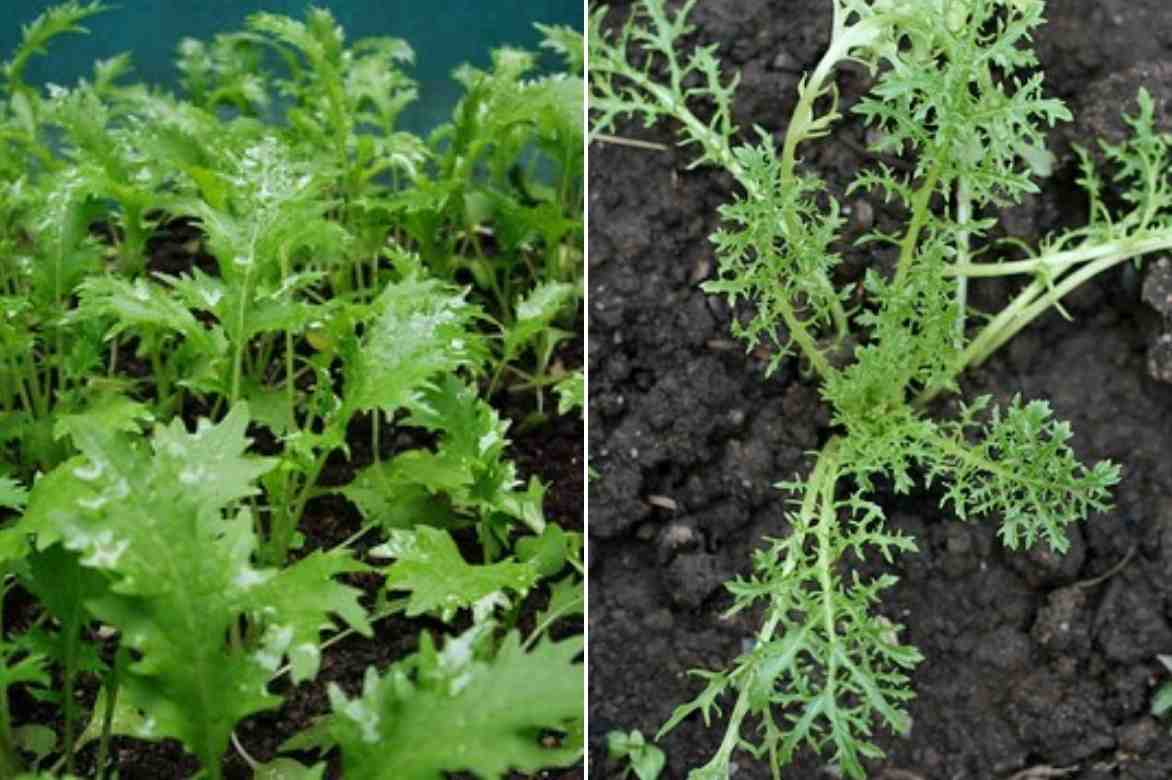
Young mizuna seedlings (Photo: Isaac’licious) and a more developed plant (Photo: Ayako Ezaki)
Read also
Sowing and pricking out cabbagesCultivation, care, and companions
Hardy, Mizuna is low-maintenance once established. Water regularly in summer, especially during prolonged dry spells, to keep the soil moist: its only weakness is its tendency to bolt quickly during periods of intense heat. Mulch with fallen leaves to maintain sufficient coolness at the base, reducing the need for watering.
Resistant to diseases, you simply need to protect its young shoots from the appetite of gastropods: discover our 7 ways to fight slugs effectively and naturally.
In winter, if severe frosts are forecast, protect your Mizuna plants with fleece.
In companion planting, it thrives alongside corn, lamb’s lettuce, and other salads. Like cabbages, Mizuna is a greedy plant, so it’s important to rotate crops in the plots: wait 1 to 2 years before replanting in the same spot.
Harvest, storage, and use
Harvesting leaves: The harvest takes place approximately 4 to 6 weeks after sowing, as needed, by cutting the leaves at the base of the rosette with a knife.
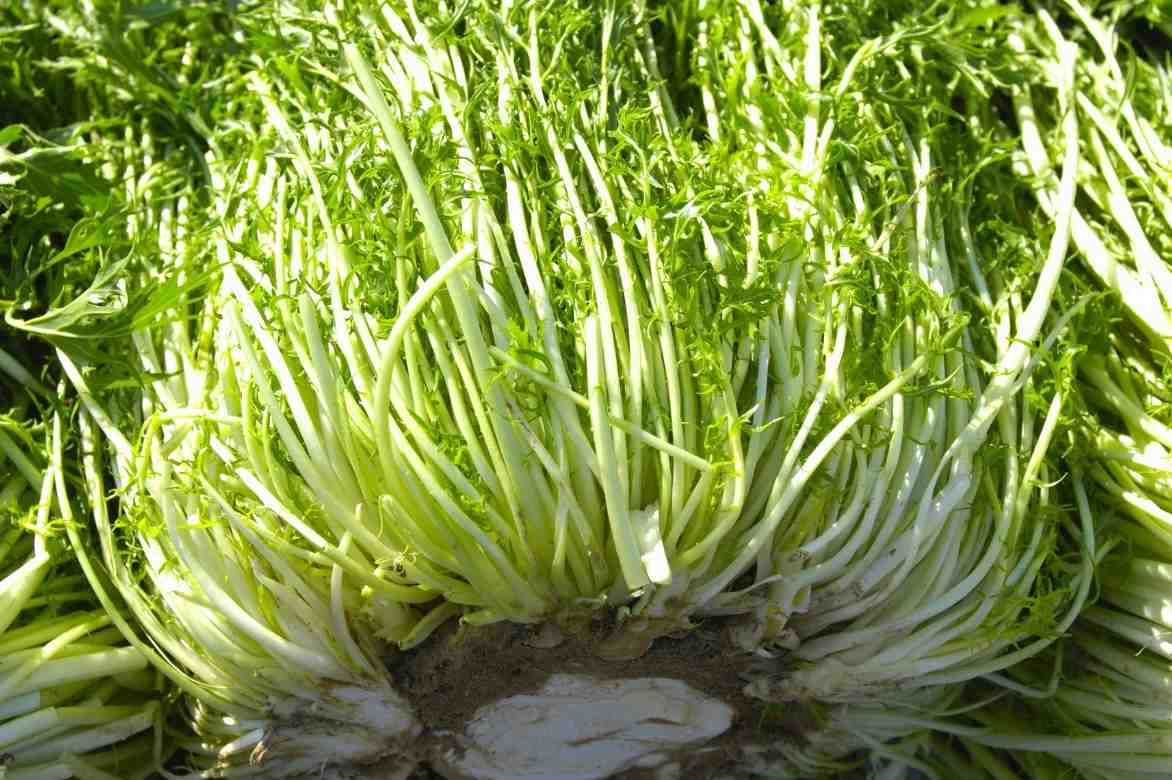 Cut the rosette at its base to harvest it
Cut the rosette at its base to harvest it
Storage: like all salads, mizuna only keeps for a few days in the vegetable drawer of the refrigerator.
Usage: Mizuna cabbage can be consumed both raw and cooked. It mixes wonderfully in a mesclun with other leaves like lettuce and rocket, stir-fried in a wok, in soup, cooked like spinach, with fish, or finely sliced on a pizza. It can also make a delicious pesto for pasta or flavour pickled preserves like gherkins. It is traditionally prepared in a “namuru” sauce in Asian cuisine.
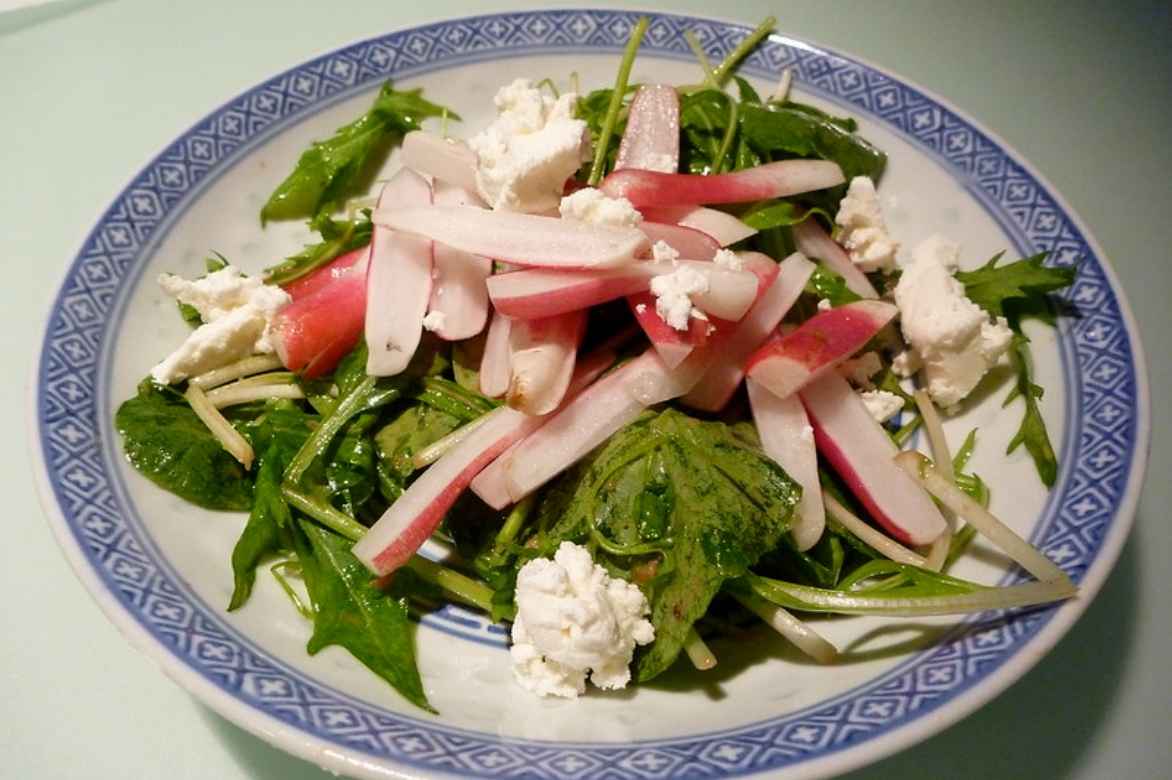 Mizuna is delicious eaten raw in salads
Mizuna is delicious eaten raw in salads
Benefits and properties of Mizuna
From a dietary perspective, this Japanese cabbage is remarkable: low in calories, it is packed with antioxidants, vitamins A, C, and K, and contains calcium. Rich in folic acid and fibre, it aids in blood clotting, strengthens bones, eyes, and the immune system.
Propagating
Mizuna easily multiplies by sowing (see our sowing section above).
Useful resources
- Discover our varieties of Mizuna
- Find our tips for successfully growing Mizuna
- 7 superfoods to grow in your garden
- Our full guide on Perilla or Shiso
- Subscribe!
- Contents
































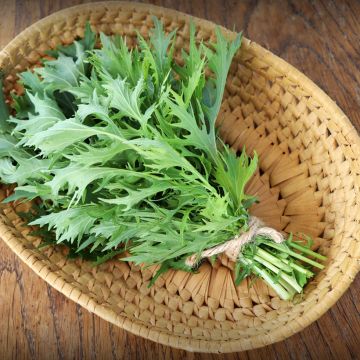
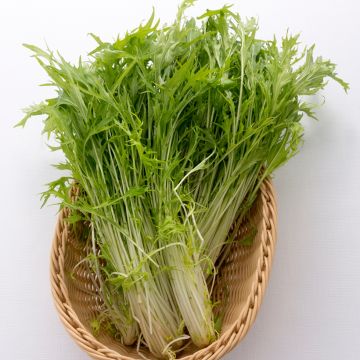

Comments